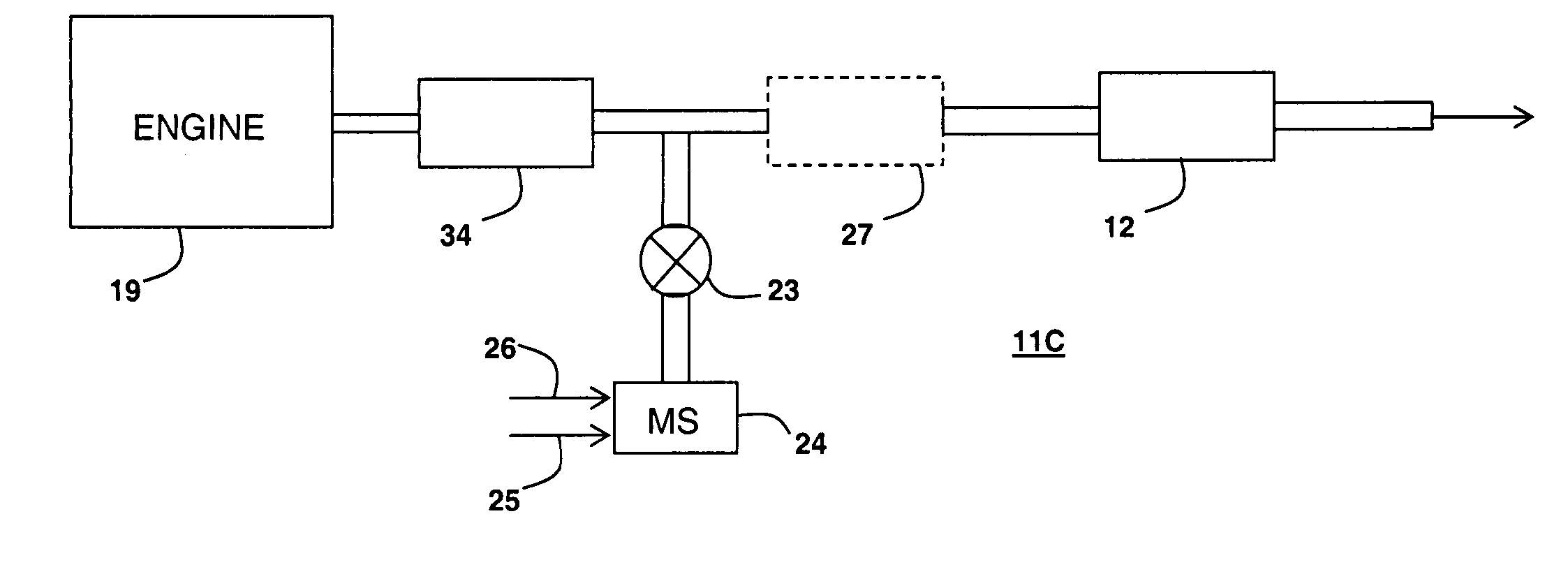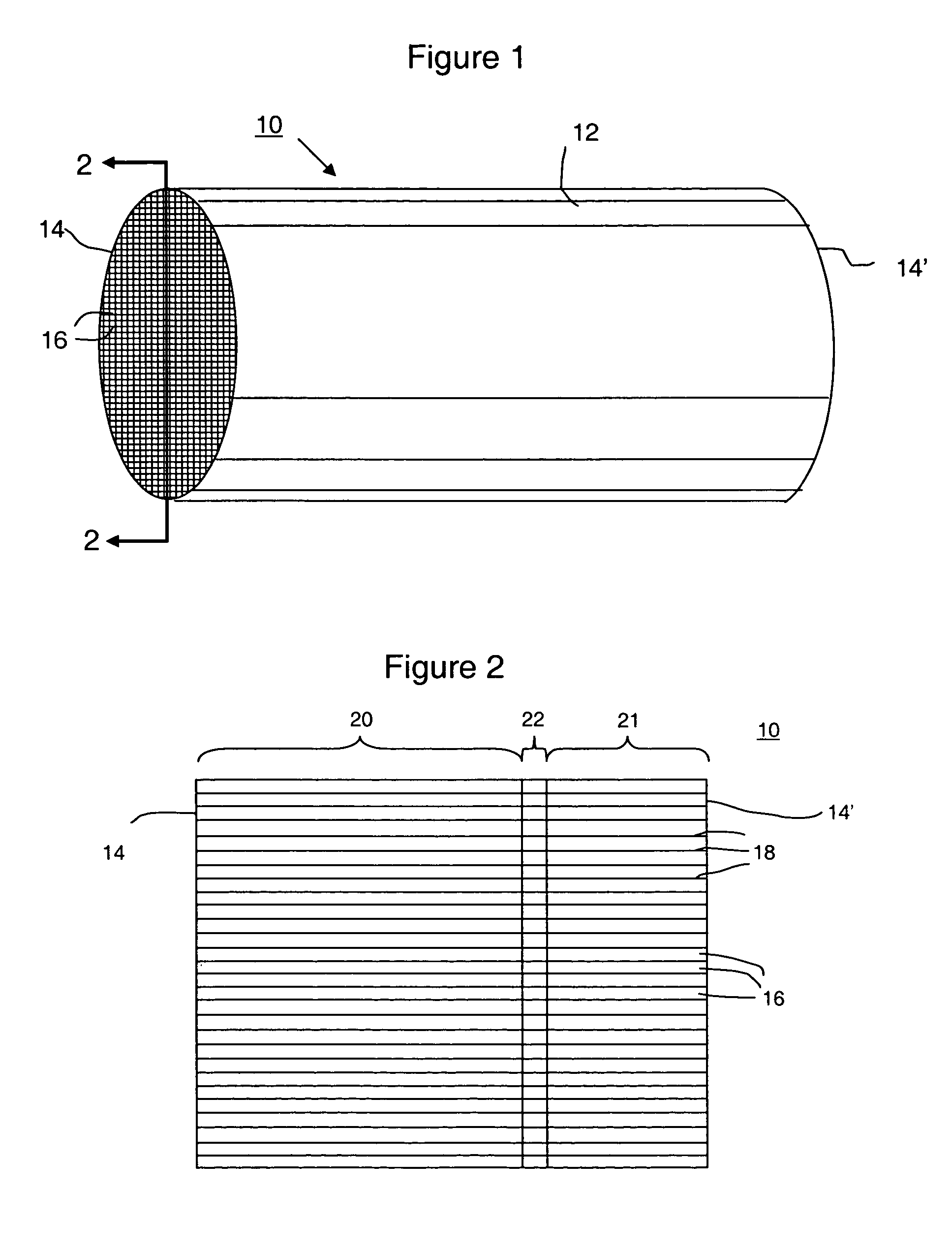Zone coated catalyst to simultaneously reduce NOx and unreacted ammonia
a catalyst and ammonia treatment technology, applied in physical/chemical process catalysts, metal/metal-oxide/metal-hydroxide catalysts, separation processes, etc., can solve the problem of not providing the system with significant ammonia over such stoichiometric amount, and the difficulty of removing nox from the exhaust gases of the system,
- Summary
- Abstract
- Description
- Claims
- Application Information
AI Technical Summary
Benefits of technology
Problems solved by technology
Method used
Image
Examples
example 1
Preparation of Zoned Substrate with an Inlet Zone Having a Copper-Exchanged Beta-Zeolite Catalyst Composition and an Outlet Zone Having a Platinum-Containing Catalyst (Catalyst Substrate A1).
[0090] Catalyst Substrate A1 was a zone coated catalyst substrate containing an inlet zone having a copper-exchanged beta-zeolite catalyst composition as an SCR catalyst and an outlet zone containing platinum-containing catalyst composition as an NH3 destruction catalyst.
[0091] Preparation of the washcoat slurry used to form the SCR catalyst is described below (Slurry A1). Copper-exchanged β-zeolite (5733.6 g) was combined with a surfactant (0.10% by weight of solids), 90% acetic acid (2.0% by weight of solids) and sufficient water to form a slurry containing 38% by weight of solids. The mixture was milled continuously so that 90% of the particles had a particle size of 13 microns. Zirconium acetate (266.4 g) was added, and mixing was continued in a high shear mixer for an additional 20 min. ...
example 2
Preparation of Zoned Substrate with an Inlet Zone Having a Vanadium-Based Catalyst Composition and an Outlet Zone Having a Platinum-Containing Catalyst-Substrate D-1
[0099] Substrate D-1 was a zone coated substrate containing an inlet zone having a vanadium-based catalyst composition as an SCR catalyst and an outlet zone containing a platinum-containing catalyst composition as an NH3 destruction catalyst.
[0100] Preparation of the washcoat slurry (Slurry C1) used to form the SCR catalyst is described below. Ammonium metavanadate (2001.96 g) was added to a heated solution of citric acid in water. The mixture was agitated for 30 min and then cooled to room temperature. Colloidal silica (4666.57 g) and additional water were added to the cooled mixture, and the resulting mixture was mixed for 5 min using a high shear mixer. A first portion of 10 wt. % tungsten (VI) oxide dispersed on titanium dioxide (74665.17 g) was added to the mixture and the resulting mixture was mixed for 5 min. A...
example 3
Evaluation of Catalyst Substrate A1 for NOx Conversion and NH3-Removal
[0106] Samples for evaluation were previously cut cores or were cored from larger pieces using the full length of the substrate. Each sample was approximately 1 inch in diameter. Prior to testing the honeycombs were trimmed to an approximately square cross section and total number of cells exposed to the gas flow were counted. Knowing the number of open cells, the “honeycomb cell density” (cells per square inch) and the sample length, it was possible to accurately determine the gas flow to achieve a targeted space velocity. The space velocity has units of 1 / hours (hr−1) and was calculated with the gas flow referred to engineering standard conditions (20° C., 1 atm). To ensure that gas flows only though the sample, a ceramic felt was wrapped around the sample and then the whole assembly was press fit into a metal sample holder.
[0107] Evaluations were conducted using a test gas composition containing 500 ppm ammo...
PUM
| Property | Measurement | Unit |
|---|---|---|
| temperature | aaaaa | aaaaa |
| temperature | aaaaa | aaaaa |
| temperature | aaaaa | aaaaa |
Abstract
Description
Claims
Application Information
 Login to View More
Login to View More - R&D
- Intellectual Property
- Life Sciences
- Materials
- Tech Scout
- Unparalleled Data Quality
- Higher Quality Content
- 60% Fewer Hallucinations
Browse by: Latest US Patents, China's latest patents, Technical Efficacy Thesaurus, Application Domain, Technology Topic, Popular Technical Reports.
© 2025 PatSnap. All rights reserved.Legal|Privacy policy|Modern Slavery Act Transparency Statement|Sitemap|About US| Contact US: help@patsnap.com



